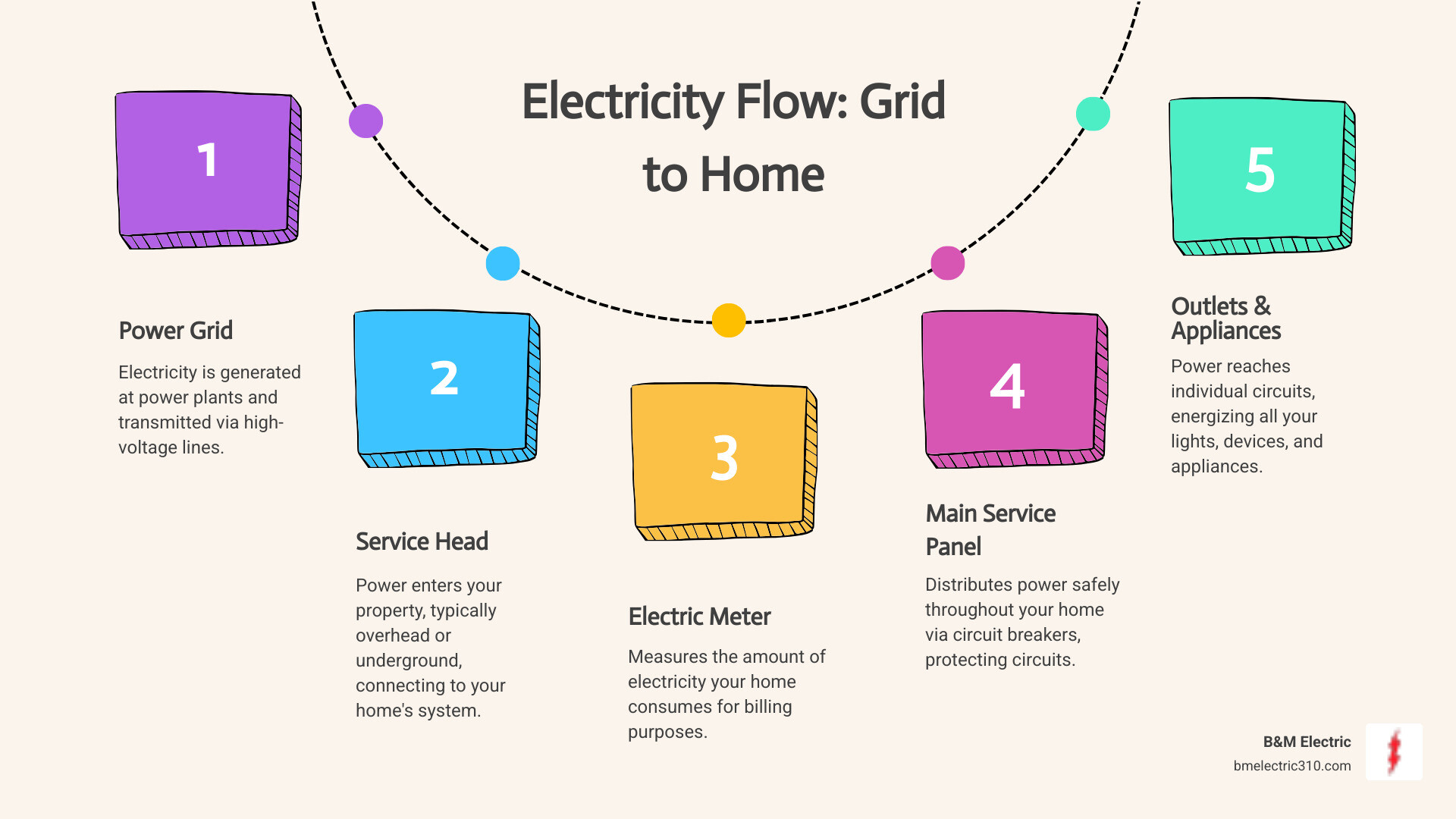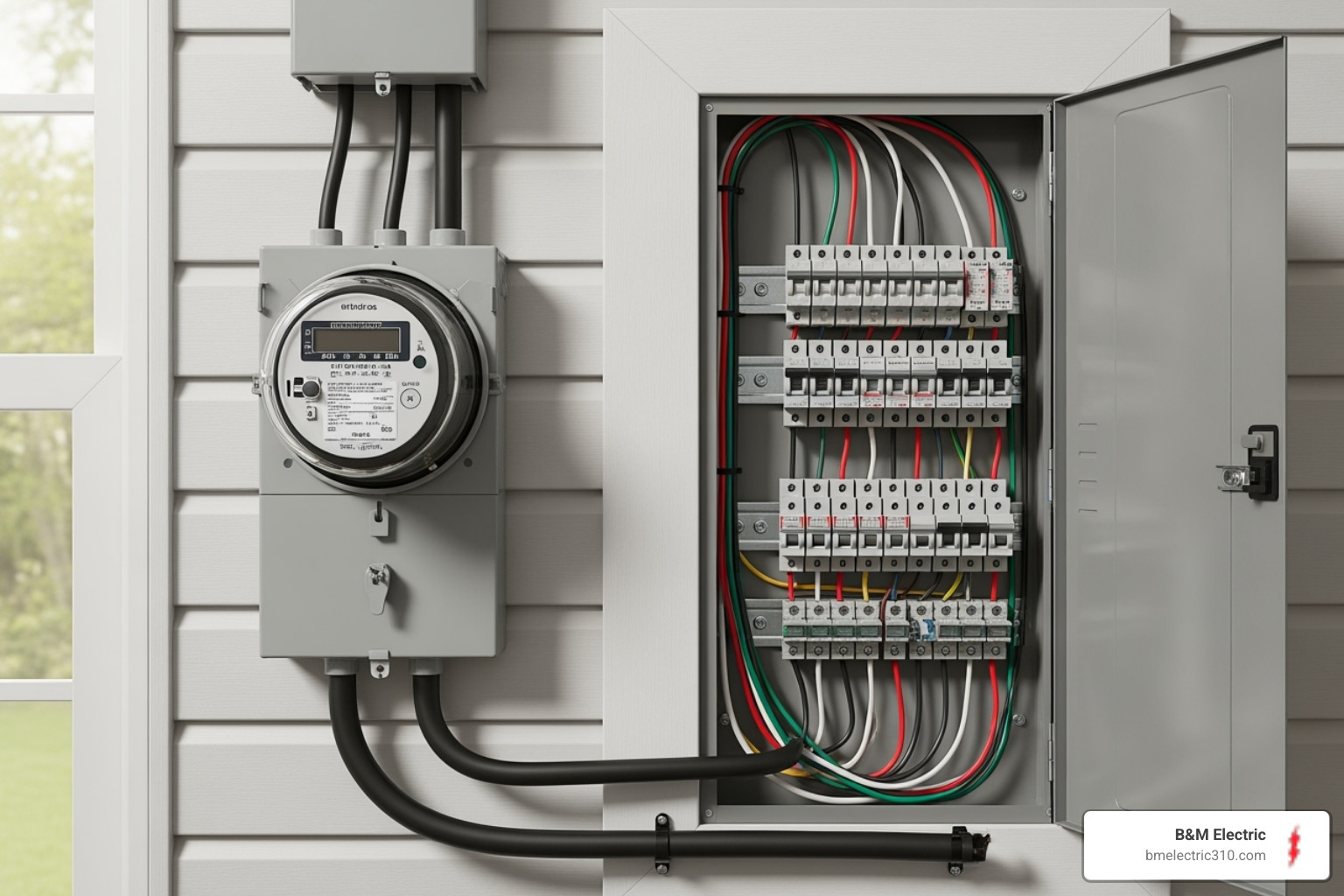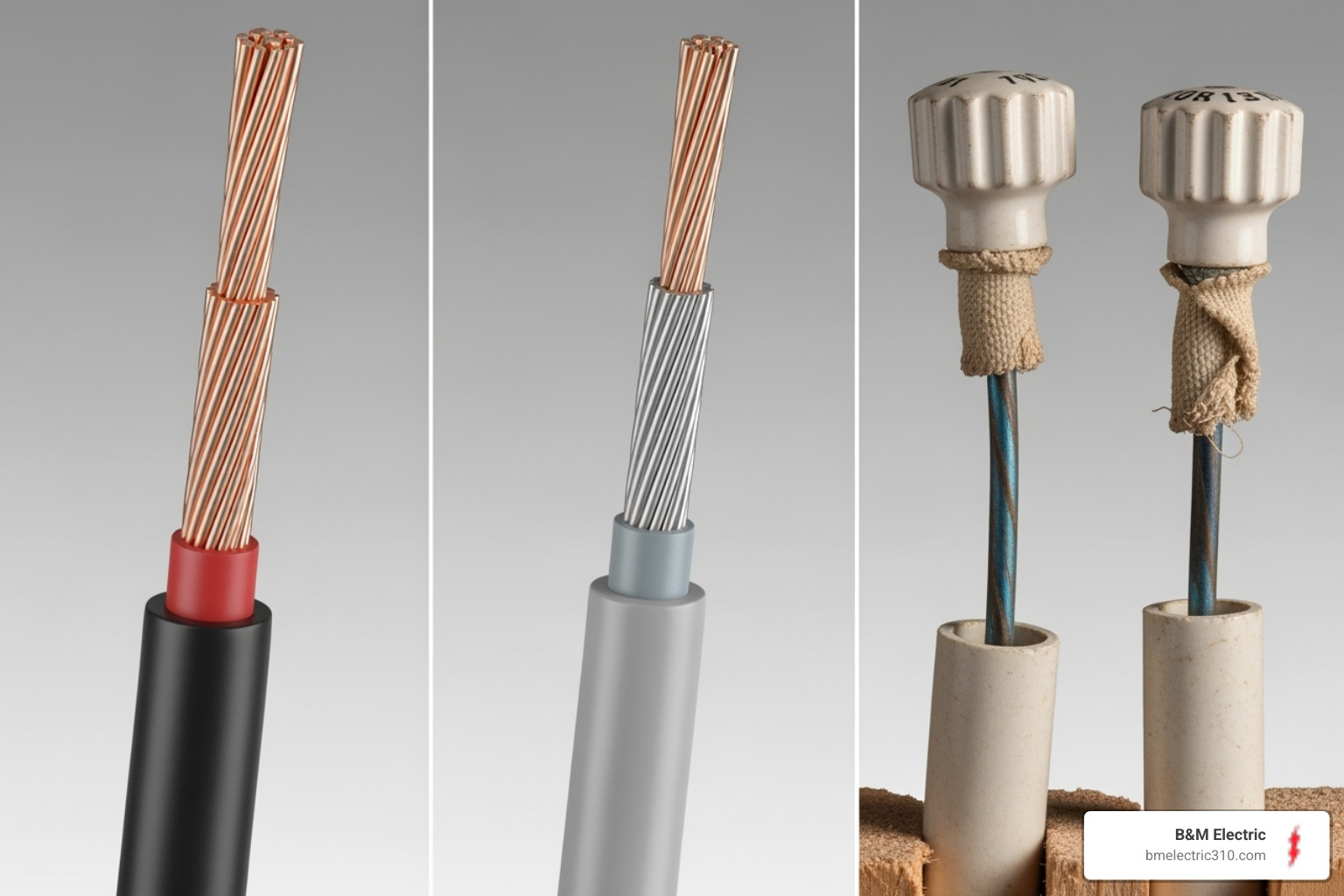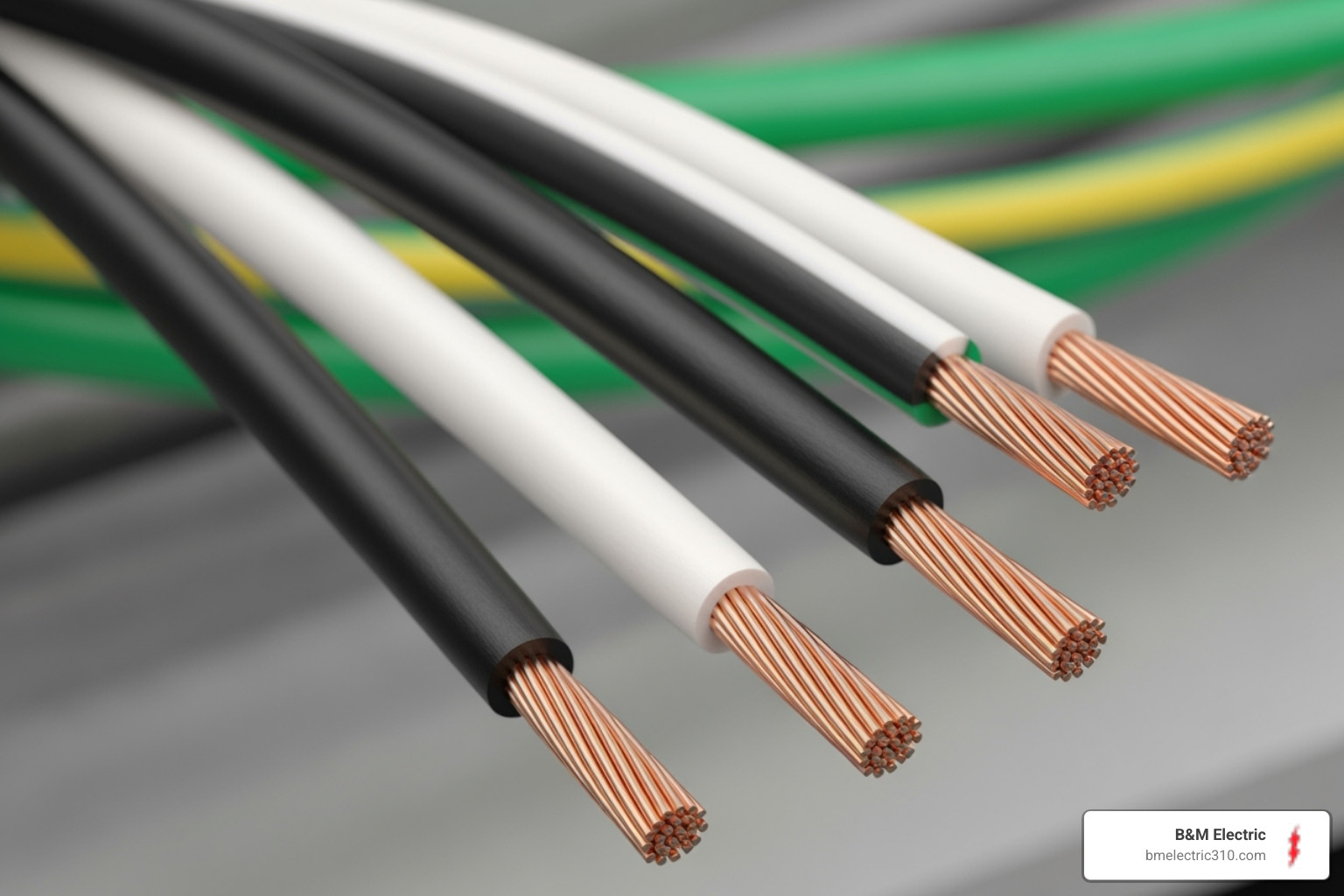Power Up Your Pad: Understanding Electrical Wiring for Your Home
By B&M ElectricSeptember 17, 2025
Electrical wiring for homes: Secure Your Power 2025
Why Understanding Your Home’s Electrical System Matters
The electrical wiring for homes is the invisible network that powers modern life. Understanding its basics is essential for any homeowner focused on safety and property protection.
Quick Overview of Home Electrical Wiring:
- Main Components: The service panel, circuit breakers, wires, outlets, and switches work together to distribute electricity safely.
- Wire Types: Copper is the modern standard, while older aluminum (1960s-70s) and knob-and-tube (pre-1950) wiring pose significant risks.
- Key Safety Features: Proper grounding, correct wire gauge, and code-compliant installation prevent fires and electrocution.
- Warning Signs: Flickering lights, frequent breaker trips, burning smells, or two-prong outlets indicate potential problems.
Think of your home’s electrical system as its circulatory system; problems don’t fix themselves and tend to worsen over time, increasing risks.
Homes built before 1970 often have outdated wiring that poses serious risks. Knob-and-tube wiring lacks proper grounding and can’t handle modern electrical loads. Aluminum wiring is prone to overheating and fire hazards. Your home insurance company recognizes these risks, and outdated systems can lead to higher premiums or even coverage denial.
The good news is that understanding the basics helps you make informed decisions about maintenance and when to call a professional. This knowledge is key to protecting your family and your investment.

The Anatomy of Your Home’s Electrical System

Electricity flows through a network of pathways to power your home. Here’s how it travels from the street to your outlets.
From the Street to Your Outlets
Your home’s electrical journey starts at the service head, the weatherproof connection where utility lines meet your house. From there, power flows through your electric meter, which tracks your usage for billing.
The next stop is the main service panel (or breaker box), the central hub that distributes all power throughout your home.
Inside the panel, circuit breakers (modern, resettable switches) or fuses (older, single-use devices) protect your wiring from overloads. Breakers “trip” and can be flipped back on, while fuses “blow” and must be replaced.
From the panel, electricity travels via two main circuit types. 120-volt circuits power everyday items like lights and small appliances. For heavy-duty appliances like electric stoves and dryers, your home uses 240-volt circuits that deliver double the power.
If your panel is old or can’t handle modern electrical demands, you may need to consider Electrical Panel Upgrades.
The Wires and Cables That Power Your Life
Let’s clarify the terms: a wire is a single conductor, while a cable is a bundle of wires in a protective sheath.
- Nonmetallic (NM-B) cable, often called “Romex,” is the standard for interior residential wiring. Its jacket color indicates the wire gauge: white for 14-gauge (15-amp), yellow for 12-gauge (20-amp), and orange for 10-gauge (30-amp).
- Underground Feeder (UF) cable is waterproof and designed for outdoor use and direct burial in the ground.
- Armored (AC/BX) cable has a flexible metal sheath for extra physical protection and is often found in older homes or specific applications.
- Individual conductors (THHN/THWN) are single wires run through protective conduit (metal or plastic tubes), offering flexibility for future upgrades.
Each type of electrical wiring for homes serves a specific purpose to create a safe and reliable system.
Decoding Your Home’s Wiring: Types, Identification, and Risks

The type and age of your home’s wiring directly impact safety, value, and even your insurance premiums. Let’s decode the three main types you might encounter.
Modern Standard: Copper Wiring
If your home was built after the 1970s, it likely has copper wiring—the modern gold standard. Its key benefits include:
- Superior conductivity for efficient power flow.
- High durability and resistance to corrosion.
- A dedicated ground wire for improved safety.
Copper meets all modern electrical codes and is strongly preferred by insurance companies.
Outdated and Risky: Aluminum and Knob-and-Tube
Aluminum wiring, common in the 1960s-70s, expands and contracts with temperature changes. This can loosen connections at outlets and switches, creating a serious fire hazard.
Knob-and-tube wiring, found in pre-1950s homes, is even riskier. It lacks a safety ground wire, its insulation becomes brittle and hazardous over time, and it cannot handle the electrical demands of modern households. These issues are so prevalent that we cover them in our guide to Electrical Repair Issues in Older Homes. Outdated wiring isn’t just an inconvenience; it’s a safety hazard that can affect your home insurance.
How to Identify the Type of Electrical Wiring for Homes
Your home’s age is the biggest clue: pre-1950s suggests knob-and-tube, 1960s-70s points to aluminum, and post-1970s usually means copper. For a visual inspection in an unfinished basement or attic, look for the wire’s appearance. Never touch exposed wires; if you are unsure, call a professional for an assessment.
| Feature | Copper Wiring | Aluminum Wiring | Knob-and-Tube Wiring |
|---|---|---|---|
| Common Age | Post-1970s | 1960s-1970s | Pre-1950s |
| Appearance | Yellowish-red metal in plastic sheathing | Silvery-gray metal, “AL” markings | Individual cloth-insulated wires with ceramic supports |
| Ground Wire | Yes (bare copper or green) | Often missing or improper | No |
| Primary Risks | Very low when properly installed | Overheating, fire hazard at connections | Fire hazard, electric shock risk |
| Insurance Impact | Standard coverage | Higher premiums, coverage issues | Very high premiums, often uninsurable |
The Language of Wires: Understanding the Basics of Electrical Wiring for Homes

The size and color of electrical wires are governed by strict safety standards that prevent fires and electrocution. Understanding these basics helps you stay safe and make informed decisions about your home’s electrical wiring for homes.
Wire Gauge and Ampacity: Matching the Wire to the Load
In the American Wire Gauge (AWG) system, a smaller number means a thicker wire that can carry more electrical current (ampacity). Using the wrong size wire is a fire hazard. Here’s a quick guide:
- 14-gauge wire (15 amps): Used for basic lighting circuits and standard outlets.
- 12-gauge wire (20 amps): The workhorse for most general-use outlets in modern homes.
- 10-gauge wire (30 amps): For larger appliances like electric dryers and window AC units.
- 8-gauge, 6-gauge, and thicker: For heavy-duty appliances like electric ranges and central air systems.
You can learn more about wire gauge sizes to understand the technical specifications.
The Rainbow of Safety: Electrical Wire Color Coding
Wire colors are a universal safety language. Knowing the code is crucial for safety.
- Hot Wires (Black, Red): These carry live electrical current from the panel. Treat them with extreme caution.
- Neutral Wires (White, Gray): These complete the circuit. Though called “neutral,” they can still carry current and be dangerous.
- Ground Wires (Green, Bare Copper): These are safety wires that provide a path for stray electricity to escape harmlessly.
- Traveler Wires (Blue, Yellow): These are often used in more complex setups like three-way switches, which control a single light from two locations.
This standardized system ensures that electricians everywhere speak the same language. You can learn the basics of wire color codes for a deeper dive.
Safety, Codes, and When to Call a Professional

While understanding your home’s wiring is empowering, working on it requires extreme caution. Knowing when to DIY versus when to call a professional is critical for your safety.
Essential Electrical Safety Precautions
- Always turn off the power at the circuit breaker before starting any work.
- Always use a voltage tester to verify that the power is completely off. Never trust a wall switch alone.
- Never work on live wires. If you cannot confidently confirm the power is off, call a professional electrician.
- Ensure proper grounding for all installations to provide a safe path for excess current.
- Avoid overfilling electrical boxes with too many wires, which can damage insulation and create a fire risk.
For more details, you can review these Electrical Safety Principles.
Common Problems with Electrical Wiring for Homes and How to Address Them
Recognizing warning signs can prevent small issues from becoming major hazards.
- Flickering lights: Can indicate loose connections or an overloaded circuit.
- Tripping breakers: Frequent trips signal that a circuit is overloaded or has a fault.
- Dead outlets: Could be a tripped breaker, a failed GFCI outlet, or a loose wire.
- Burning smells or scorched outlets: This is an immediate fire hazard. Turn off the circuit and call an electrician immediately.
- Outdated wiring capacity: If your system struggles with modern appliances, it may be time for an upgrade, especially if you have aluminum or knob-and-tube wiring.
Learn more about these Electrical Warning Signs to Watch For.
Navigating the Rules: The National Electrical Code (NEC)
The National Electrical Code (NEC) is the benchmark for safe electrical installation in the U.S. Its primary purpose is to protect people and property from electrical hazards. Local building codes often add their own requirements.
Compliance, confirmed through proper permits and inspections, is essential for safety, home value, and insurability. Correctly interpreting and applying these complex standards is a job for a licensed electrician. You can learn more about The National Electrical Code (NEC).
Frequently Asked Questions about Home Electrical Wiring
Here are concise answers to the most common questions we receive about electrical wiring for homes.
How does my home’s wiring affect my home insurance?
Your wiring type directly impacts your home insurance. Insurers view outdated systems like knob-and-tube or aluminum as high-risk for fire, which can lead to higher premiums or even coverage denial. Modern, grounded copper wiring is the standard for safety and insurability.
What’s the difference between a circuit breaker and a fuse?
Both protect circuits from overloads, but a fuse is a single-use device that melts and must be replaced. A circuit breaker is a reusable switch that “trips” and can be reset once the problem is fixed. Modern homes use circuit breakers for their convenience and safety.
When is it necessary to upgrade or replace home wiring?
An upgrade is essential for homes with outdated aluminum or knob-and-tube wiring. It’s also necessary if you’re doing a major renovation, adding large appliances (like an EV charger), or experiencing frequent issues like tripping breakers. An upgrade ensures your system can safely handle modern electrical loads.
Conclusion
Understanding your home’s electrical wiring for homes is fundamental to protecting your family and property. Recognizing different wiring types, knowing what wire colors mean, and spotting warning signs like flickering lights empowers you to be a proactive and protective homeowner.
Today’s homes demand more from their electrical systems than ever before. We’re charging electric vehicles, running smart devices, and powering home offices. Proactive maintenance is no longer optional—it’s essential.
While it’s good to know the basics, you don’t have to handle it all alone. Knowing when to call in a professional for work involving wiring safety, system understanding, or meeting modern electrical demands is just as important.
For residents in Torrance and throughout the South Bay, ensuring your home’s electrical system is safe and up to code is our top priority at B&M Electric. With 50 years of local expertise, we’ve seen everything from vintage wiring to the needs of modern smart homes.
We believe in dependable service with a personal touch. We’ll explain our findings, help you understand your options, and ensure you feel confident in your decisions. Whether you have an urgent issue or want the peace of mind of a professional inspection, we’re here to help.
Ready to ensure your home’s electrical system is everything it should be? Contact our expert Torrance CA electrical contractors for a professional inspection and service. Because when it comes to your family’s safety, you deserve nothing less than the best.